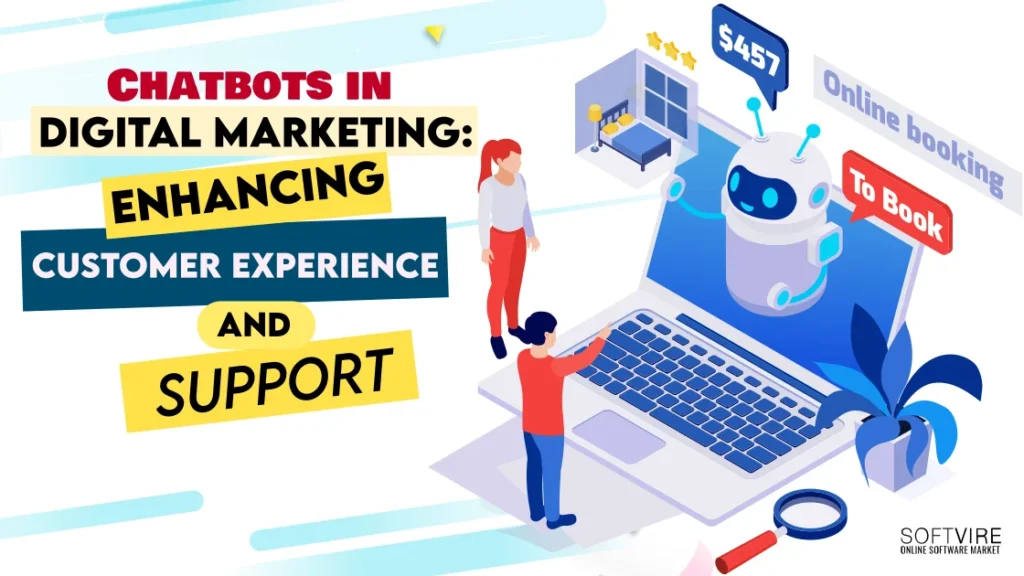Chatbots have emerged as powerful tools for enhancing customer experience and support in digital marketing. Chatbots are computer programs that mimic human speech providing automated responses and assistance to users. They play a crucial role in digital marketing by engaging with customers, addressing their queries, and delivering personalized recommendations. Enhancing customer experience and support cannot be overstated, as it directly impacts customer satisfaction, brand loyalty, and business growth.
II. Understanding Chatbots in Digital Marketing
A. Definition and functionalities of chatbots
Chatbots are software applications programmed to interact with users conversationally. They utilize various technologies, including natural language processing (NLP) and artificial intelligence (AI), to understand user inputs and provide appropriate responses. Chatbots can be linked to chat services, websites, and other applications, or mobile applications, enabling real-time conversations and information exchange.
The key functionalities of chatbots include understanding user queries, generating relevant responses, providing recommendations, collecting data, and performing automated tasks. Depending on their programming and capabilities, they can be designed to handle specific tasks or engage in more complex conversations.
B. Types of chatbots used in digital marketing
- Rule-based chatbots: These chatbots operate based on predefined rules and decision trees. They follow predetermined instructions to understand user inputs and provide corresponding responses. Rule-based chatbots are ideal for handling simple and repetitive queries but may need help understanding complex or ambiguous requests.
- AI-powered chatbots: These chatbots leverage advanced technologies like natural language processing and machine learning algorithms. They can learn from user interactions, adapt to changing contexts, and provide more intelligent and personalized responses. AI-powered chatbots can handle various queries, understand user intent, and improve performance over time.
III. Benefits of Chatbots in Digital Marketing
Chatbots offer several benefits when it comes to enhancing customer experience and support in digital marketing.
A. Enhancing customer experience
- 24/7 availability and instant response: Chatbots can operate round the clock, providing immediate customer assistance anytime. This availability ensures customers receive support and information whenever needed, improving their overall experience.
- Personalized interactions and recommendations: By analyzing customer data and preferences, chatbots can deliver tailored recommendations and personalized interactions. This level of personalization creates a more engaging and satisfying customer experience.
- Efficient handling of customer queries: Chatbots quickly and accurately address common customer queries. They can retrieve information from databases, FAQs, or knowledge bases, enabling prompt responses and reducing customer waiting time.
B. Improving customer support
- Automated issue resolution and troubleshooting: Chatbots can guide customers through troubleshooting steps or solve everyday problems. This automated support reduces the need for human intervention and accelerates issue resolution.
- Seamless integration with other customer support channels: Chatbots can seamlessly integrate with customer support channels such as email, social media, or live chat. This integration ensures a consistent and cohesive customer support experience across multiple touchpoints.
- Scalability and cost-effectiveness: Chatbots are highly scalable and can handle multiple customer interactions simultaneously. This scalability makes them cost-effective compared to traditional customer support methods, as they can handle a larger volume of queries without requiring additional human resources.
IV. Use Cases of Chatbots in Digital Marketing
Chatbots find applications in various areas of digital marketing, playing a crucial role in improving customer engagement and support.
A. Lead generation and qualification
- Chatbots as virtual assistants for lead capturing: Chatbots can engage website visitors or social media users, collecting relevant information and qualifying them as leads. They can ask targeted questions, provide information about products or services, and capture user data for further marketing efforts.
- Automated lead qualification and nurturing: Chatbots can analyze user responses and data to determine lead quality and assign appropriate lead scores. They can also engage in automated lead nurturing campaigns, delivering personalized content and guiding leads through the sales funnel.
B. Customer engagement and retention
- Chatbots for proactive engagement and follow-ups: Chatbots can initiate conversations with customers, providing proactive support or follow up on previous interactions. This proactive engagement keeps customers engaged, addresses their concerns, and enhances their overall experience.
- Personalized recommendations and product suggestions: By analyzing customer preferences and purchase history, chatbots can deliver personalized recommendations and product suggestions. This helps customers discover relevant products, increases cross-selling and upselling opportunities, and boosts customer satisfaction.
C. E-commerce and sales support
- Chatbots for product information and assistance: Chatbots can provide real-time product information, answer questions about features or specifications, and guide customers through the purchasing process. This instant and accurate support enhances the customer’s shopping experience and increases the likelihood of conversion.
- Order tracking and status updates: Chatbots can retrieve order information from databases or external systems, allowing customers to inquire about their order status or track their shipments. This self-service functionality reduces customer inquiries and provides transparency throughout order fulfillment.
V. Best Practices for Implementing Chatbots in Digital Marketing
To maximize the effectiveness of chatbots in digital marketing, it’s essential to follow best practices in their implementation and management.
A. Defining clear goals and objectives
Clearly define the goals and objectives you want to achieve through chatbot implementation. Whether improving customer satisfaction, increasing sales or reducing support costs, having clear goals helps align chatbot functionalities and strategies.
B. Designing conversational flows and user journeys
Design intuitive and user-friendly conversational flows that align with the customer journey. Ensure that chatbots can handle different queries and provide appropriate responses conversationally. Optimize the user experience by minimizing the number of steps and providing clear instructions.
C. Integrating chatbots with existing marketing platforms
Examples include integrating chatbots with existing marketing platforms, Customer relationship management (CRM) systems, and marketing automation solutions. This integration allows chatbots to access relevant customer data, provide personalized responses, and ensure consistent communication across channels.
D. Monitoring and optimizing chatbot performance
Regularly monitor chatbot performance and gather feedback from customers. Analyze chat transcripts, track key metrics, and identify areas for improvement. Continuously optimize the chatbot’s responses and behaviors based on user interactions and feedback.
E. Ensuring data privacy and security
Implement robust data privacy and security measures to protect customer information. Comply with applicable data protection standards and ensure the security of chatbot interactions and data storage. Communicate your privacy policies to customers to build trust and maintain confidentiality.
VI. Challenges and Limitations of Chatbots in Digital Marketing
While chatbots offer numerous benefits but also have challenges and limitations that must be addressed.
A. Language understanding and natural language processing limitations
Chatbots may need help understanding and interpreting complex or ambiguous user queries accurately. Natural language processing algorithms may face challenges in accurately identifying user intent and providing appropriate responses, especially in slang, colloquialisms, or language nuances.
B. Maintaining a human-like conversational experience
Creating a chatbot that delivers a human-like conversational experience can be challenging. It requires a careful balance between automated responses and personalized interactions. Ensuring that chatbots understand context, maintain empathy, and provide relevant and engaging responses is crucial for a positive user experience.
C. Handling complex or sensitive customer queries
Chatbots may encounter difficulties when handling complex or sensitive customer queries that require human intervention. Some queries may be beyond the capabilities of chatbots, requiring escalation to human agents. It’s essential to have a seamless handover process from chatbots to human agents to ensure customers receive the necessary support.
D. Balancing automation with human intervention
Determining the appropriate level of automation versus human intervention is a challenge. While automation helps in efficiency and scalability, there are cases where human touch and expertise are necessary. Striking the right balance between automation and human intervention is crucial to provide optimal customer support and experience.
VII. Future Trends and Innovations in Chatbots for Digital Marketing
The field of chatbots in digital marketing continues to evolve with advancements and emerging trends. Some future trends and innovations to watch out for include:
A. Voice-enabled chatbots and virtual assistants
Voice-enabled chatbots and virtual assistants are gaining popularity, allowing users to interact with chatbots using voice commands. Integration with voice assistants such as Amazon Alexa and Google Assistant allows for more natural and hands-free engagement.
B. Integration of chatbots with emerging technologies (e.g., AR/VR)
Chatbots can be integrated with emerging technologies like augmented reality (AR) or virtual reality (VR) to provide immersive and interactive experiences. This integration can enhance product visualization, virtual try-on, or real-time assistance.
C. Advanced sentiment analysis and emotion detection
Advancements in sentiment analysis and emotion detection technologies will enable chatbots to understand customer emotions and better tailor responses. This capability can lead to more empathetic and personalized interactions, enhancing the customer experience.
D. Multi-lingual and cross-channel chatbot capabilities
Chatbots will continue to improve their multi-lingual capabilities, allowing businesses to engage with customers in their preferred languages. Moreover, chatbots will become more versatile in handling conversations across multiple channels, including websites, social media platforms, messaging apps, and more.
Conclusion
In conclusion, chatbots play a significant role in enhancing customer experience and support in digital marketing. They provide 24/7 availability, personalized interactions, and efficient handling of customer queries. Chatbots find use in lead generation, customer engagement, e-commerce support, and other areas.
Businesses can leverage chatbots to optimize their digital marketing efforts by implementing best practices and addressing challenges. With future trends and innovations on the horizon, chatbots will continue to evolve, enabling even more seamless and engaging customer experiences in the digital realm.
Check out the different Microsoft software products today if you need trusted software that uses AI ethically and efficiently. They continue to lead in using AI for their many office tools like Office 365. Get discounted Office 365 in New Zealand now!



